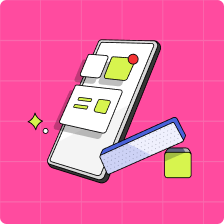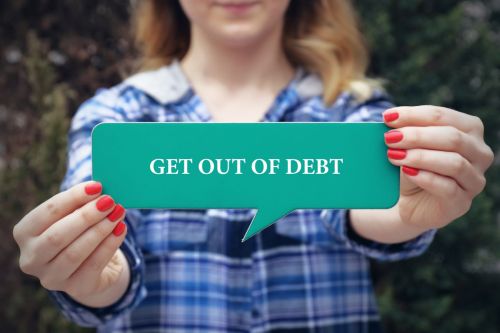It’s a four-letter word that makes a lot of adults cringe: debt. Teenagers, however, can have a hard time understanding the ramifications of paying down debt. That’s why two of the most important lessons you, as a parent, can teach your kids are how to make a budget and how to pay down debt.
This article covers teaching teens about debt: what it is, why people end up in debt, and how to help them avoid unmanageable levels of money owed.
Key takeaways
- Debt is the total amount of money borrowed through personal loans, credit cards, car loans, mortgages, and school loans.
- Credit is how much you can potentially borrow in the future, whereas debt is how much money you owe today.
- Poor budgeting can contribute to debt, as can life circumstances beyond our control.
- Paying debt is more manageable with a low debt-to-income ratio.
- Debt consolidation places multiple loans into one single loan.
- Smart budgeting, along with a loan calculator, can help teens understand, manage, and control the amount of debt they take on.
What is debt?
If you owe money, either to a person, a business, or a financial institution, you’re in debt. Long before teens take on any debt, get them to think about whether a loan or new credit card will help them meet their financial goals or could actually make goals harder to reach. A credit card, for example, can help them make larger purchases, such as textbooks or a new winter jacket. But if credit card purchases aren’t managed carefully, high interest rates could make this debt difficult to pay back.
Another thing kids need to know: There’s good debt and bad debt. Good debt can be thought of as something that could help you achieve long-term goals, increase earning potential, or otherwise improve your life in some way. A low-interest student loan for college or university tuition is one example. Or you could give your younger teen a small business loan to fund their creative side business. If these loans are paid back in full, they’re considered good debt.
Bad debt, on the other hand, might build up through impulse buying or need-it-now purchases: luxe items charged to a credit card, in-app upgrades, or an expensive vacation with friends that they can’t really afford. If your teen can pay off all these things at the end of the month—great! It’s not considered bad debt when they can afford it. But bad debt is more likely to build (and build) when someone can’t come up with the money to pay everything back. Bad debt doesn’t ever help you in the long term.
Read more about the most common types of debt.
What’s the difference between credit and debt?
Having credit means a lender has agreed to give you a loan and you have agreed to pay back the full amount borrowed, usually with interest. Debt is the dollar amount you have already borrowed and must pay back, plus any interest. Put another way, credit is how much you could potentially borrow in the future, whereas debt is how much you have already borrowed in the past.
What causes debt?
Borrowing and spending more money than you bring in every month will contribute to debt. The math is reasonably simple, so teens may assume it’s easy to spend within their means. But let them know that there may be sneaky ways debt seeps in. For example, if their income is low but they live in an expensive city, they may rely on credit cards to pay living expenses. Or maybe their car breaks down and a high-interest loan is the only way to get it fixed. Even if your teen ends up making a decent amount of money, one of the simplest causes of debt is not keeping a budget. It’s more challenging to keep debt at bay if you have no idea how much money is coming or going. If they don’t create a budget, anyone can get caught in a cycle of debt, no matter how much money they earn.
In some cases, people get into debt by spending future money that never materializes. Take Clark Griswold in the 1989 classic National Lampoon’s Christmas Vacation. Clark bought a swimming pool with the Christmas bonus he thought he was getting. Instead, his boss enrolled him in the Jelly of the Month Club!
Unexpected life events, such as job loss, an accident, or illness, could also place a person into debt. On the brighter side, debt can be a result of funding post-secondary education, which should help your teen get ahead in life over the long term.

How much is too much debt?
When loan payments are so high that there isn’t enough money left over for necessities like food, housing, utility bills, and a little fun, you could have too much debt. Experts use a term called debt-to-income ratio, or DTI, which compares your income to the amount of debt you have. With a low DTI, you can more easily afford your loans and life necessities and even handle additional debt in the future.
A good debt-to-income ratio varies for adults, but generally, less than 36 per cent is considered good or a reasonable amount of debt. However, 50 per cent or more is considered the danger zone.
How to calculate your debt-to-income ratio
Add up the total of your loan payments, divide by your gross income, and multiply by 100. For example, if your all loan payments add up to $1,500 and your gross monthly income is $3,250:
$1,500 / $3,250 = 0.46
0.46 x 100 = 46, for a DTI of 46 per cent
With this DTI being on the high end, this person is likely having a hard time paying down their debts and paying for necessities every month. It’s important to note that DTI doesn’t consider high-interest credit card debt over lower-interest loans, nor does it factor in lifestyle costs, like high city rent, for example.
What to tell your kids: If they find themselves in debt, don’t panic. There is always a way forward to managing money and eventually becoming debt-free. One great tool? A budgeting app that can look at your spending habits and help you manage your finances so you can save money and pay down debt.
What is debt consolidation?
To simplify debt payments across multiple loans and potentially pay everything back faster, you could roll all the money you owe into a single consolidated loan.
To consolidate debt, you’ll need to speak to a credit specialist at a financial institution. Based on your income level, outstanding debt balances, and future financial goals, a credit specialist can suggest different debt consolidation options. Depending on the circumstances, this can be a smart move—you could save on interest costs, save time with just one payment per month, and regain a sense of control over your finances.
How teens can avoid getting into debt
With their developing brains prone to impulsive decisions, teens and young adults could be susceptible to getting into debt. So, one of the best things you can do as a parent is include teens in important conversations about money, bills, credit, and debt reduction. If you familiarize kids with family finances early on, they’re more likely to feel positive and confident about tackling their own budgeting challenges.
Share how you pay your bills online with your kids, or go over your credit card statements with them every few months. If you’ve put more on your credit card than you’d like, show teens how easy it can be to overspend when you aren’t paying with cash.
Think about this: Kids are growing up in an increasingly cashless society. They’re less likely to see their parents paying bills with cheques or even counting out dollars and cents to buy groceries. In their own lives, in-app purchases and subscriptions to streaming services are all attached to a credit card. Even a tap of their smartphone or smartwatch can grant them lunch, new shoes, or a fun night out. It’s easy for kids to not attach dollar values to much of anything.
You can also look at debt calculators together and show them why you need to pay your credit card bill in full every month. In addition to seeing how interest accumulates, teens need to understand how late payments will affect their credit score and their financial future. Don’t avoid the conversation—learning how to use credit cards responsibly can help your kids steer clear of unmanageable debt.
5 tips for teaching kids about debt
No, you don’t have to prepare TED Talk-level lesson plans. Instead, begin small and make the debt talk tangible. Start with simple concepts like trade-off decisions (should you really lose a day’s pay to see a concert?), spending wisely, saving with goals, and how to give back through charitable donations. Here are a few more tips for money talks around the kitchen table:
1. Only borrow what you can pay back
Impulse purchases on a credit card are easy to make; paying them back isn’t always. Help teens handle debt with their eyes wide open by showing them how credit works, the importance of paying off the balance every month, and when to use cash to avoid racking up a credit card bill. While some credit card companies offer student cards with lower interest rates, teens still need to learn restraint and only charge what they can afford to pay back.
2. Help them consider whether an item is a want versus a need
In other words, is the thing they have their eye on truly an essential or a nice-to-have? One way to encourage this thinking early on is by allowing your teen to pay for needs and wants themselves. They’ll quickly learn how purchases add up each week and each month and that the sky doesn’t fall if they miss out on some things their friends might have.
3. Make a personal budget and stick to it
Knowing where your dollar is going is one of the best ways to a) avoid getting into debt and b) staying out of debt. There’s something about punching in the numbers and seeing how much money you actually have to play with for the month that makes it more real. After allocating money for every upcoming bill and expense and then seeing how much fun money they’ve got remaining at the end, kids are more likely to stick to their budget.
Tip: Our free savings goal calculator can help teens create a personalized savings plan.
4. Understand how much debt will cost to repay
Telling teens they’ll pay an extra $20 tomorrow on something that’s $100 today may or may not be effective. Instead, use an online credit card and debt calculator to show them just how long it can take to pay down even just a few hundred dollars in accumulated debt and how much extra they’ll pay in interest that could have been put toward a short-term goal, such as a trip.
5. Ignoring debt could get you in trouble
What happens if a debt isn’t paid? This can be hard for a teen to grasp. They may think debt is no big deal because they hear people talk about how much money they owe all the time. But they need to know that if their rent, student loan, or phone bill isn’t paid, those debts may be sent to a collection agency. This will cause their credit score to go down, which means lenders may refuse them access to credit later on or charge a higher interest rate.

How to pay off debt
You can pay down debt by making a budget that aligns with your income, spending, and values. Stick to it, making extra payments whenever you can.
It’s not always easy. Debt can accumulate quickly, and an egg that has been scrambled cannot be put back in the shell. But even if your teen winds up with multiple credit cards and personal loans, they can move forward.
Show kids how to create a debt reduction plan that will help them pay down debt as quickly as possible—and work for them in other ways. One thing your teen needs to know is that making minimum payments means that it will take a long time to pay off a debt. Instead, throwing as much money at the debt as possible will accelerate the rate at which they pay it off. A debt repayment calculator along with some smart strategies can help, too. Here are two ways to do it.
The snowball method
One method that works is the debt snowball method, which can be applied to most personal debt—student loans, car loans, credit card balances, phone bills, etc. It goes like this: First, make a list of all your outstanding debts, from highest dollar amount to lowest. Then, make minimum payments on all of these debts and funnel any extra money you have toward the smallest debt in order to pay this one down first. Once it’s paid off, strike that debt off the list and put your focus on the next-smallest debt.
Here’s where it gets interesting: By using the minimum payments you were originally putting into that first small debt, now you can double-down on this next-smallest debt. And so on and so on. The snowball method is very motivating when you start to receive fewer bills and see these debts disappear.
The avalanche method
With the debt avalanche method, you start the same way as you do with the snowball method: by listing all of your outstanding debts, but this time from highest interest rate to lowest. Start by making the minimum payments on all debts. But instead of putting the bullseye on the debt with the smallest dollar amount, the avalanche method targets the debt with the highest interest rate. Put any extra money you have toward the high-interest debt to whittle it down. Then, when that one is paid off, you move on to the debt with the next-highest interest rate, and so on and so on.
Note: The avalanche method may save you more money in the long run, but it may also make it take longer to pay off each debt, which isn’t as immediately gratifying as the snowball method. Both methods work, but, really, the best method is the one that you can actually put into practice.
Why Mydoh is a smart alternative to going into debt
Let’s face it: It can be tough for kids to grasp the concept of credit and the debt that’s attached to it. But the good news is, there’s help available. The Mydoh Smart Cash Card is a reloadable prepaid Visa debit card for kids.
That means that when tweens and teens use their Smart Cash Card, there’s no interest rate charged or risk of debt, since they can only spend the money that’s available. And you can send money to your kids’ Mydoh Smart Cash Card quickly and easily through the app. The best part is that parents have oversight, so you can encourage and guide your kids to make smart financial decisions.
We all have a certain amount of money to buy things with, save for tomorrow, or share with others. By giving teens the confidence to manage their own money early on, you’re helping them understand the concepts of budgeting and managing debt as well as giving them the tools they need for a bright financial future.
Download Mydoh and help build the foundation of financial literacy for your kids and teenagers.
This article offers general information only and is not intended as legal, financial or other professional advice. A professional advisor should be consulted regarding your specific situation. While the information presented is believed to be factual and current, its accuracy is not guaranteed and it should not be regarded as a complete analysis of the subjects discussed. All expressions of opinion reflect the judgment of the author(s) as of the date of publication and are subject to change. No endorsement of any third parties or their advice, opinions, information, products or services is expressly given or implied by Royal Bank of Canada or its affiliates.













